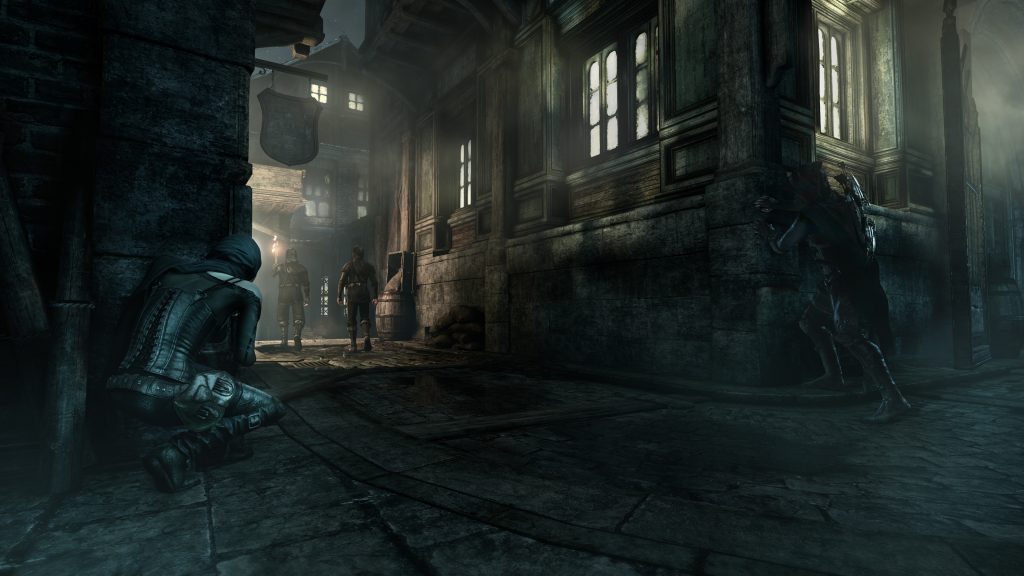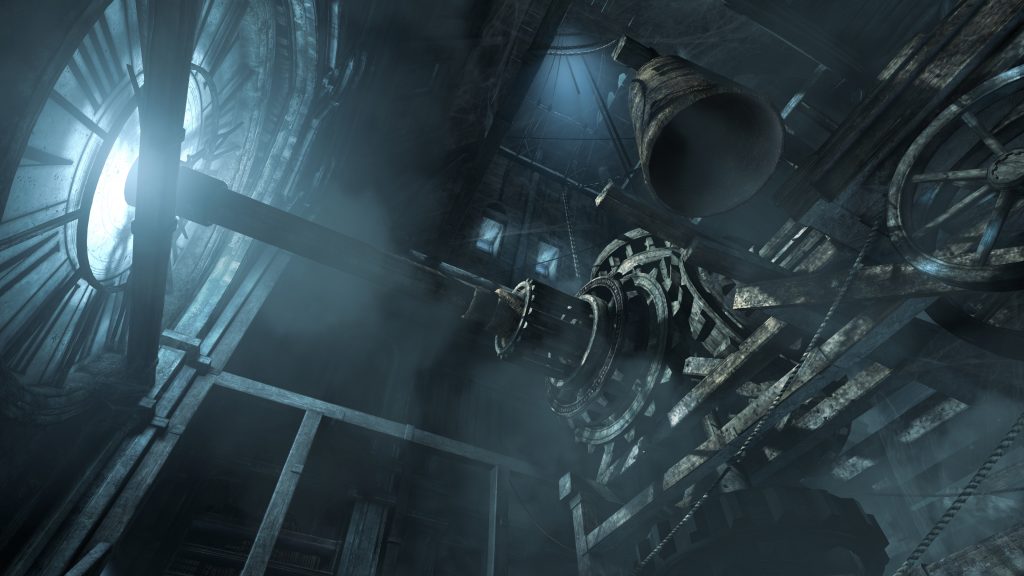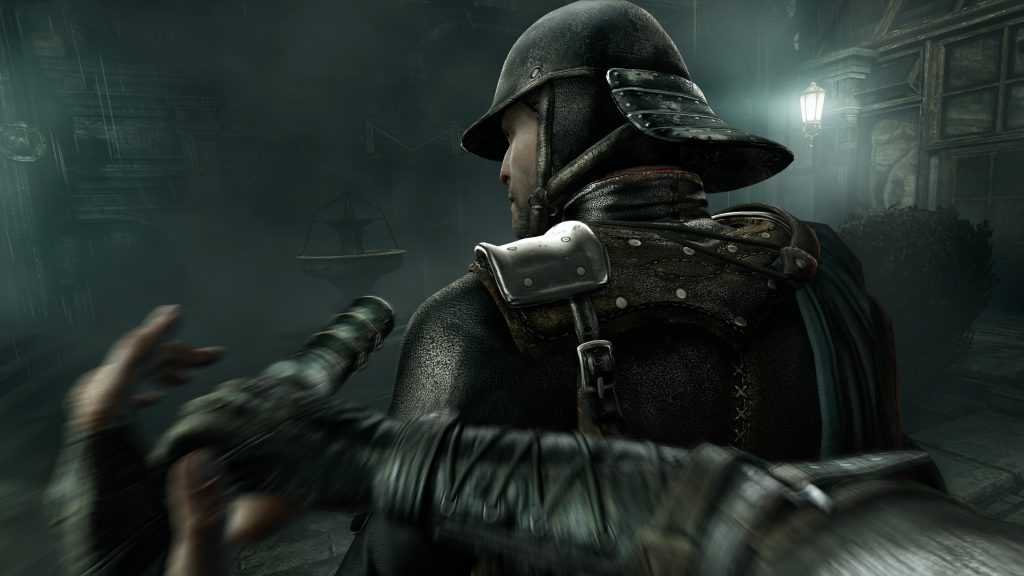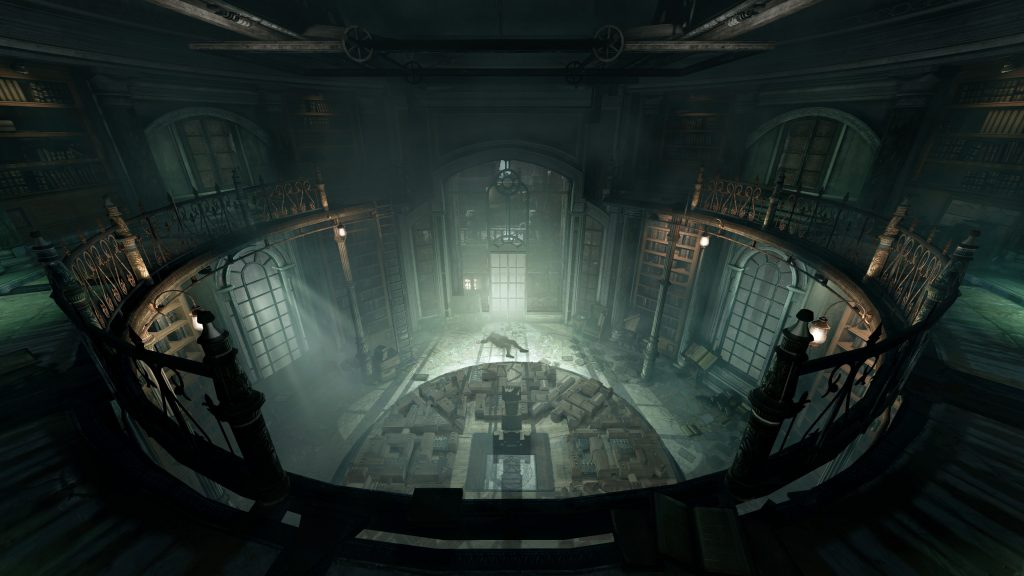I recently spent just over three and a half hours with a preview build of Thief, the fourth game in the popular pilfering franchise that’s coming out later this month.
I got to see the first two chapters in full and a snippet of the third before my time ran out, and what I played was very encouraging. I had been a bit worried about the game since reading way back in April 2013 that its development had been a bit rough, with rife in-studio politicking, favouritism and multiple lead designers who lasted no more than two years each. I had read that game was, as a result, not quite as tightly-focused as it should have been.
And then Eidos Montreal released that disappointing gameplay demo video of the game at E3 2013, showing experience points being awarded for headshots… in a game that was supposed to be about sticking to the shadows and stealing. The rumours I’d read about the developer’s lack of focus seemed to be true, and I was starting to think the new Thief game would end up being just another beloved franchise cynically ruined to appeal to a broader market.
So it was with some trepidation, then, that I attended last week’s Thief sneak preview event, hosted by Megarom at Microsoft’s Bryanston offices. That was where I got my first look at the game, in its close-to-release glory, and I was very happy to see that the feedback received in the wake of the E3 video had convinced the team at Eidos Montreal to make a few changes to bring the game more in line with its stealth roots. What I saw was a stealth-heavy game that actively discouraged killing, that didn’t have an experience point-based economy, and which appeared to have a lot of potential as a faithful yet modern-day take on the whole Thief concept. I left that sneak preview encouraged that this new Thief probably might actually be pretty good.
Sitting down with the game and playing through the sequences I had seen at the preview event and then beyond only solidified that idea. Be aware that if you read from this point, you will encounter spoilers. I will keep them to a minimum, I promise.
Thief starts off with Garrett on a job. His mission is to meet a contact on the rooftops of The City, a sprawling Victorian-era metropolis, who he will be pulling the job with. Turns out, it’s someone he knows, a young woman by the name of Erin, who may or may not be the grown version of the young girl Garrett met (and possibly apprenticed) at the end of Deadly Shadows. She serves as a bridge between the previous games and this one, even though Thief is, according to the game’s makers, a reboot of the franchise rather than a direct sequel.

The job goes awry, naturally, leading to [SPOILER ALERT] Erin’s death during some sort of summoning ritual being performed by a mysterious cult and Garrett, in trying to save her knocks himself unconscious and yes, gives himself amnesia. He wakes up a year or so later with only a fuzzy recollection of what happened, in a city that has changed completely (and not for the better) which of course sets him on a path of answer-seeking. What actually happened when Erin died? Why is the city being affected by a mysterious illness that seems connected to the gloomy fog that has settled over it? What happened during the year that changed everything for the worse?
The setup seemed a little trite to me – I was surprised Eidos had trotted out the old “I’ve forgotten stuff” trope so popular in games from the early 2000s and soap operas since time immemorial, but I found myself intrigued nonetheless.
In the next chapter I found out just how gloomy and depressing the city had become in the year since Garrett bumped his head; bodies were piling up all over the place because of the mystery illness – “The Gloom” – and the authorities appeared to have been instructed to come down hard on the city’s poor, the people most affected by it. After a brief meeting with one of Garrett’s old underworld pals, Garrett was given the job to steal a ring from a certain recently-deceased wealthy man, whose body was busy decomposing at a well-guarded nearby body-disposal plant.
Getting around in this new Thief means making your way through what are essentially interconnected hubs. Your main base is an old abandoned clock tower, and picking up missions means sneaking around to the local pub or wherever your contact tells you to meet him, and then sneaking your way into whichever part of The City the job is located in. It’s definitely no open world, but it works pretty well and the load times that separated the areas were acceptably short on the rig I was playing on.

This is where the game really opened up. Once at the right location, I was faced with patrolling guards and the occasional dog in a cage (they would bark if I got too close) and I was challenged to make my way through the level using just my smarts and thief tools. I had accumulated a fair bit of coin in the first chapter, and had the opportunity to spend my loot at a local merchant before undertaking the second mission, and had kitted myself out with water arrows, a few broadhead arrows in case I got into a scrape, an arrow for knocking people and animals out with gas and various other goodies I thought might help me. I was ready.
By changing the game’s economy from one of experience points to one based purely on money, the developers have pretty much ensured that stealing is as important to player progress as achieving each level’s primary objectives. All of the tools and abilities Garrett acquires are unlocked with money, so if you don’t steal anything, you can’t kit yourself out properly for the next mission or buy the tools needed to make effective use of the game’s environments. It’s a very clever, very subtle change that keeps gamers focused on being a thief that may occasionally get into a fight, rather than a headshotting psychopath who occasionally pilfers stuff. It goes very well with the fact that you can complete the entire game without killing a single person.
The level proved very challenging, and I got caught a few times by guards who promptly killed me. I had not upgraded any of Garrett’s fighting tools, and was pretty much a sitting duck every time I got caught which forced me to reload my latest checkpoint to try again. It didn’t bother me that Garrett was useless in a fight, to be honest, as his vulnerability really forced me to closely evaluate my options as I moved through the level lest I make a wrong step and end up on the wrong end of a sword or crossbow again. Strangely, I didn’t feel punished for messing up; I felt encouraged to be smarter.

On finally stealing the ring the game kicked into high gear, and charged me with getting away with my loot in hand with the guards hot on my heels. There’s something quite primal about being chased, and I felt rather pleased at my own cleverness when I got away by running as fast as I could and finding a nice, dark spot to hide in while the guards searched frantically for any sign of me. Now able to play shadow games again, I slowly snuck my way back to the level’s starting point, employing the tools I’d brought with me to good effect. Once I had made it out in one piece, I was immensely satisfied with my performance – getting away felt like a well-earned victory, and not a cheap inevitability.
Part of the challenge of getting away was due to some inconsistency in the environmental design. Garrett can’t jump, but he can climb and sometimes leap over obstacles. Just not all of them, and figuring out what can and can’t be traversed didn’t prove to be quite as intuitive as I’d have liked. Sure, Eidos Montreal has marked out the more obvious places Garrett can climb or leap over, but I often came across crates or debris that looked like I could climb from a purely logical standpoint, but which proved to be no more than set dressing. While this is quite minor when I was sneaking around, when I was being chased by guards and my flight was stopped dead because I hit a bit of level that I couldn’t climb or jump over, it was a tad annoying.

Of course, there’s a way to mitigate problems like that in the game, using Garrett’s Focus ability. It works just like Instinct mode in both Tomb Raider and Hitman: Absolution, in that it highlights objects of interest in Garrett’s immediate vicinity in blue. Grates that can be opened, bits of wall that can be used to climb to greater heights, stealable items and more are instantly made visible when pressing the Focus button. It even makes things like picking locks and pockets easier, but to make sure it’s not overpowered, Eidos limited its potency by ensuring it doesn’t automatically regenerate; it needs to be replenished by consuming an item, just like health.
When the feature was first announced, fan reaction was not good as many felt it undermined the ideals of the series, but fortunately it’s entirely optional in the new Thief. Focus, and much of the game’s Heads Up Display – including the light gem that shows whether Garrett is visible or not – can be turned off in the options, leaving a much more challenging Thief experience for the purists if they want it, and a more straightforward experience for those less hard-core.
The last level I got to see was the one that had so recently been in the news – the brothel. Its purported nudity and suggestive audio were among the reasons the game was given an 18+ rating by PEGI, and I was dead keen to see just how far Eidos had pushed the “mature” content. I must admit, I was a little disappointed – the brothel wasn’t the pit of depravity that my inner 15-year-old had been hoping for, but there were exposed breasts and mostly-clothed people lying together on beds, moaning, so it wasn’t exactly kid-friendly, either. There were too many guards, though, for me to have enough time to get my ogle on, and as my time was up very shortly after I entered the level I wasn’t able to see if I had perhaps missed something a little more titillating, so my inner teenager is still hopeful there is more to come.
Being a preview build, the game had a few issues – I noticed lip-synching irregularities and a few mis-timed audio cues here and there, particularly when I threw unconscious guards into dark corners – their bodies seldom thumped as they dropped to the floor. But overall I really liked what I saw: the graphics were detailed and complex, the mechanics of sneaking and stealing worked very well, and the gameplay was sufficiently challenging, even at the second-from-the-easiest difficulty I was playing on. It’s definitely going to challenge series veterans’ patience and skills, but in a good way. Plus, I’m positive Eidos Montreal will have most, if not all of the kinks ironed out by the time Thief ships in February.
The story… well, I can’t say too much about it except that it appears to be walking a fine line between over-wrought and cheesy, but then I wasn’t exactly expecting Shakespeare. And also, maybe it gets better the more you play. I wasn’t mad about the way cutscenes would often cut into my playing and take me out of my immersion, though, and I’m sure a lot of other Thief fans will feel the same. That said, these are modern times and cutscenes are all but a requirement to convey AAA game stories in a cinematic fashion, so the community will just have to grin and bear them.
At the end of my time with Thief’s preview build, I found my fears of a cynical cash-in on a great franchise name just about entirely allayed. As a result, I’m confident that the new game, which will be in shops on the 28th of February for PC, Xbox 360, PS3 and PS4, will steal the hearts of series fans with ease.

